chapter 1 student movement for racial equality - Campus Activism
chapter 1 student movement for racial equality - Campus Activism
chapter 1 student movement for racial equality - Campus Activism
Create successful ePaper yourself
Turn your PDF publications into a flip-book with our unique Google optimized e-Paper software.
nature of the discrimination they were attacking and the level of dedication of the sitinners<br />
earns them the title of social revolutionaries. Though they were unarmed, they<br />
were at war with white supremacy, one of the basic tools used by American business to<br />
divide and rule the workers in this country. Impatient with the slow pace of<br />
desegregation, the legal system, concessions, and traditional black organizations like the<br />
NAACP, they turned to the use of the extraparliamentary tactic of civil disobedience and<br />
were soon quite successful in the upper South and peripheral southern states. By<br />
addressing their grievances illegally and victoriously, they posed an enormous threat to<br />
the American political system, delegitimizing it in the eyes of many of its citizens.<br />
At the April 1960 Raleigh conference, which brought 126 <strong>student</strong> delegates<br />
together, the <strong>student</strong>s decided to remain independent of adult organizations (like the<br />
Southern Christian Leadership Conference and the Congress of Racial Equality) but to<br />
maintain friendly ties. At the conference, a keynote speaker Rev. Martin Luther King, Jr.<br />
articulated the <strong>movement</strong>'s rejection of the NAACP and other "old" black middle-class<br />
groups. King characterized the sit-in <strong>movement</strong> as a "revolt against those Negroes in the<br />
middle class who have indulged themselves in big cars and ranch-style homes rather than<br />
in joining a <strong>movement</strong> <strong>for</strong> freedom," (West, 1984, p. 47).<br />
This desire <strong>for</strong> autonomy distinguishes the <strong>student</strong> <strong>movement</strong> from the 1930's<br />
<strong>movement</strong> and from their white contemporaries of SLID who didn't break from their<br />
parent organization until 1962. This mood has characterized the <strong>student</strong> <strong>movement</strong> in the<br />
U.S. ever since and <strong>for</strong>ms the beginnings of the New Left <strong>movement</strong>.<br />
In the statement of purpose adopted at the Raleigh Conference, the <strong>student</strong>s<br />
declared:<br />
We affirm the philosophical or religious ideal of nonviolence as the<br />
foundation of our purpose, the pre-supposition of our faith, and the<br />
manner of our action. Nonviolence as it grows from Judaic-Christian<br />
traditions seeks a social order of justice permeated by love. Integration of<br />
human endeavor represents the first step towards such a society…. (Cohen<br />
and Hale, 1967, Appendix).<br />
They decided to set up an office, hire a secretary to staff it, print a newsletter<br />
called The Student Voice, raise funds, plan nonviolent training <strong>for</strong> the summer and<br />
coordinate the various activities in the South. Their goals were to end segregation and<br />
discrimination, assure southern blacks of the right to vote, and to seek fair employment<br />
laws among others.<br />
For the most part, the participants in the sit-ins were "not middle class re<strong>for</strong>mers<br />
who became somehow concerned about others. They come themselves from the ranks of<br />
the victims,…[in general] they are young, they are Negro, they come from the South,<br />
their families are poor and of the working class, but they have been to college. Northern<br />
middle class whites and Negroes are a minority," (Zinn, 1965, pp. 9-10).<br />
Black <strong>student</strong>s first began to confront the UT Regents around this time. 4 After<br />
months of discussion, on March 11, 1960 a group of <strong>student</strong>s held the first civil rights<br />
protest conducted by <strong>student</strong>s at UT. They demonstrated on the fringe of the campus<br />
4 Although there had been protests during the 1950's on the UT campus, the participants in these<br />
demonstrations were members of the community demanding that the university be opened to African-<br />
American <strong>student</strong>s.<br />
7


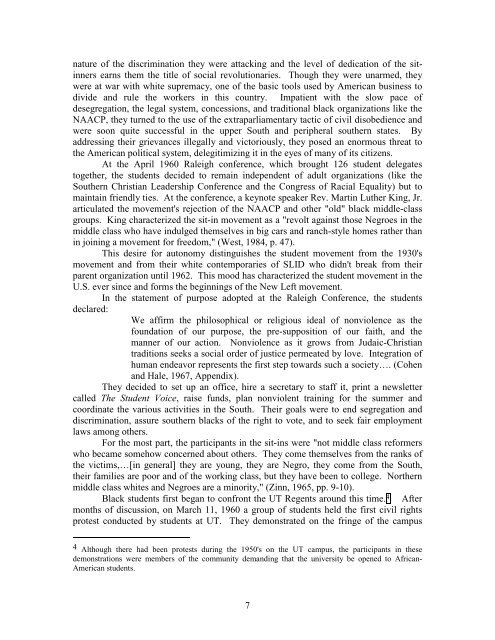
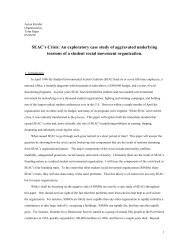
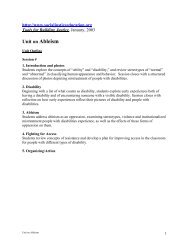

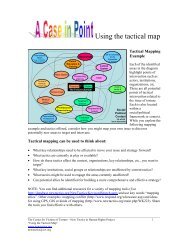
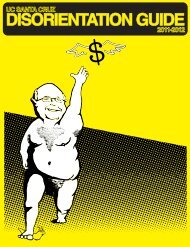

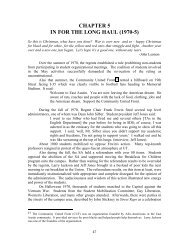


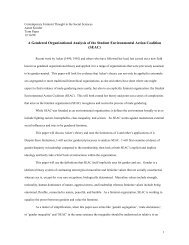

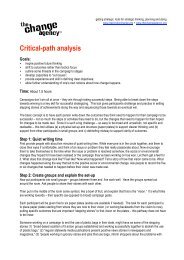

![Meaningful Student Involvement Research Guide [pdf] - SoundOut](https://img.yumpu.com/38822556/1/190x231/meaningful-student-involvement-research-guide-pdf-soundout.jpg?quality=85)